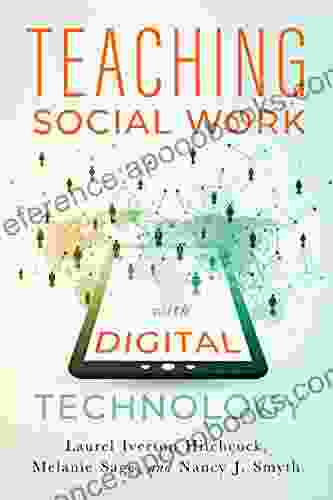Teaching Social Work With Digital Technology: A Comprehensive Guide


Digital technology is rapidly transforming the field of social work. From online learning platforms to virtual reality simulations, technology offers new and innovative ways to teach and learn social work content. However, integrating technology into social work education requires careful planning and consideration of ethical issues.
This comprehensive guide provides social work educators with the knowledge and skills needed to effectively teach social work with digital technology. The book covers a wide range of topics, including:
4.6 out of 5
| Language | : | English |
| File size | : | 10991 KB |
| Text-to-Speech | : | Enabled |
| Enhanced typesetting | : | Enabled |
| Word Wise | : | Enabled |
| Print length | : | 673 pages |
| Screen Reader | : | Supported |
- The benefits and challenges of using digital technology in social work education
- Innovative strategies for using digital technology to teach social work content
- Ethical considerations for using digital technology in social work education
- Best practices for integrating digital technology into social work curricula
This book is essential reading for social work educators who are interested in using digital technology to enhance their teaching. It provides a wealth of practical information and resources that can help educators create effective and engaging learning experiences for their students.
Also Included
- Case studies of successful digital technology implementations in social work education
- A glossary of terms related to digital technology in social work
- A resource guide for finding digital technology resources for social work education
Chapter 1: The Benefits and Challenges of Using Digital Technology in Social Work Education
The first chapter of the book provides an overview of the benefits and challenges of using digital technology in social work education. The benefits of using digital technology include:
- Increased access to education: Digital technology can make social work education more accessible to students who live in rural areas or who have other barriers to attending traditional face-to-face classes.
- Enhanced learning experiences: Digital technology can be used to create engaging and interactive learning experiences that can improve student learning outcomes.
- Preparation for the future: Digital technology is playing an increasingly important role in the field of social work. By integrating technology into their education, social work students can prepare for the future of the profession.
The challenges of using digital technology in social work education include:
- Cost: Digital technology can be expensive to Free Download and maintain.
- Equity: Not all students have equal access to digital technology.
- Technical support: Digital technology can be complex to use, and students may need technical support.
Chapter 2: Innovative Strategies for Using Digital Technology to Teach Social Work Content
The second chapter of the book provides innovative strategies for using digital technology to teach social work content. These strategies include:
- Using online learning platforms: Online learning platforms can be used to deliver social work content in a flexible and convenient way.
- Using virtual reality simulations: Virtual reality simulations can be used to create immersive learning experiences that allow students to practice social work skills in a safe and controlled environment.
- Using social media: Social media can be used to connect students with social work professionals and to share social work content.
Chapter 3: Ethical Considerations for Using Digital Technology in Social Work Education
The third chapter of the book discusses the ethical considerations for using digital technology in social work education. These considerations include:
- Privacy: Digital technology can collect and store a lot of personal data about students. It is important to use digital technology in a way that protects student privacy.
- Equity: Digital technology can create new barriers to access education for students who do not have equal access to technology.
- Informed consent: Students should be informed about the risks and benefits of using digital technology before they consent to use it.
Chapter 4: Best Practices for Integrating Digital Technology into Social Work Curricula
The fourth chapter of the book provides best practices for integrating digital technology into social work curricula. These best practices include:
- Starting small: Don't try to implement too much digital technology at once. Start with small, manageable projects.
- Getting feedback from students: Ask students for their feedback on how they are using digital technology in the classroom.
- Being flexible: Digital technology is constantly changing. Be prepared to adjust your plans as needed.
Digital technology is a powerful tool that can be used to enhance social work education. However, it is important to use digital technology carefully and ethically. This book provides social work educators with the knowledge and skills needed to effectively teach social work with digital technology. It is a must-read for any social work educator who wants to use technology to improve student learning.
4.6 out of 5
| Language | : | English |
| File size | : | 10991 KB |
| Text-to-Speech | : | Enabled |
| Enhanced typesetting | : | Enabled |
| Word Wise | : | Enabled |
| Print length | : | 673 pages |
| Screen Reader | : | Supported |
Do you want to contribute by writing guest posts on this blog?
Please contact us and send us a resume of previous articles that you have written.
 Book
Book Novel
Novel Page
Page Chapter
Chapter Text
Text Story
Story Genre
Genre Reader
Reader Library
Library Paperback
Paperback E-book
E-book Magazine
Magazine Newspaper
Newspaper Paragraph
Paragraph Sentence
Sentence Bookmark
Bookmark Shelf
Shelf Glossary
Glossary Bibliography
Bibliography Foreword
Foreword Preface
Preface Synopsis
Synopsis Annotation
Annotation Footnote
Footnote Manuscript
Manuscript Scroll
Scroll Codex
Codex Tome
Tome Bestseller
Bestseller Classics
Classics Library card
Library card Narrative
Narrative Biography
Biography Autobiography
Autobiography Memoir
Memoir Reference
Reference Encyclopedia
Encyclopedia Cecil Castellucci
Cecil Castellucci Chris Masi
Chris Masi Janet Tanner
Janet Tanner Howard Jackson
Howard Jackson David Putnam
David Putnam Tony Sharp
Tony Sharp Aaron Shearer
Aaron Shearer Abramo Basevi
Abramo Basevi Abdulrazak Gurnah
Abdulrazak Gurnah John Jackson Miller
John Jackson Miller Paul Auster
Paul Auster Jeffrey D Stocks
Jeffrey D Stocks Scott Jansen
Scott Jansen Eli Berman
Eli Berman Andy Ziker
Andy Ziker Chandran Nair
Chandran Nair Reuven Y Hazan
Reuven Y Hazan Jim Crace
Jim Crace Daniel Boscaljon
Daniel Boscaljon A L Knorr
A L Knorr
Light bulbAdvertise smarter! Our strategic ad space ensures maximum exposure. Reserve your spot today!

 Julio Ramón RibeyroIdentity, Political Culture, and the Tea Party Movement: An Anthropological...
Julio Ramón RibeyroIdentity, Political Culture, and the Tea Party Movement: An Anthropological...
 Bruce SnyderUnlock the Power of Literacy in Secondary Grades: Essential Guide to Literacy...
Bruce SnyderUnlock the Power of Literacy in Secondary Grades: Essential Guide to Literacy... James GrayFollow ·17k
James GrayFollow ·17k Tim ReedFollow ·5.8k
Tim ReedFollow ·5.8k Robert Louis StevensonFollow ·11k
Robert Louis StevensonFollow ·11k Aron CoxFollow ·3.1k
Aron CoxFollow ·3.1k Walter SimmonsFollow ·17.8k
Walter SimmonsFollow ·17.8k Chris ColemanFollow ·3.5k
Chris ColemanFollow ·3.5k Jaylen MitchellFollow ·8.6k
Jaylen MitchellFollow ·8.6k Jay SimmonsFollow ·5.3k
Jay SimmonsFollow ·5.3k

 Justin Bell
Justin BellUnlock National Biology Success: The Ultimate Guide to...
Mastering the Fundamentals: A Comprehensive...
 Luke Blair
Luke BlairAC/DC: The Early Years with Bon Scott – A Thunderstruck...
In the annals of rock and roll history, few...

 Darren Nelson
Darren NelsonSpinal Cord Medicine Second Edition: The Comprehensive...
The second edition of Spinal Cord Medicine...

 Cole Powell
Cole PowellArabian Horse Training: Unlock the Secrets for a...
Indulge in the captivating world of Arabian...

 Oscar Wilde
Oscar WildeRevise Curriculum For Excellence SQA Exams: The Ultimate...
The Scottish...

 David Peterson
David PetersonEndoscopic Ear Surgery: A Comprehensive Guide for...
Endoscopic Ear...
4.6 out of 5
| Language | : | English |
| File size | : | 10991 KB |
| Text-to-Speech | : | Enabled |
| Enhanced typesetting | : | Enabled |
| Word Wise | : | Enabled |
| Print length | : | 673 pages |
| Screen Reader | : | Supported |








